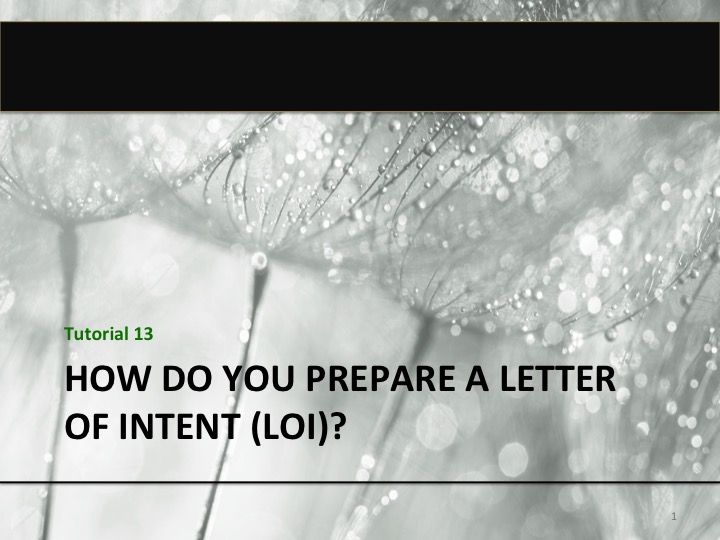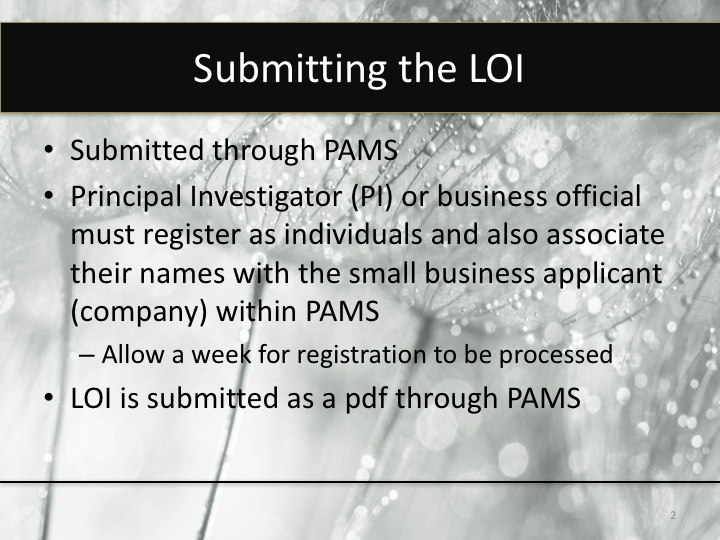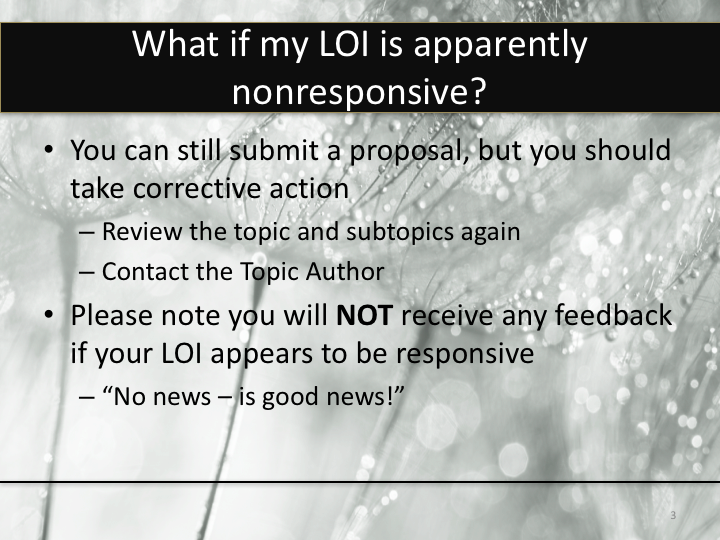Tutorial 13:
How do you prepare a Letter of Intent (LOI)
The U.S. Dept of Energy (DOE) is unique in its requirement that Phase I SBIR/STTR applicants must submit a Letter of Intent (LOI) before submitting a full proposal. The LOI is mandatory at DOE, meaning the agency will not accept a Phase I SBIR/STTR proposal from a small business applicant if it did not submit an LOI by the deadline. The deadline for the LOI typically is about 7 weeks after the Department of Energy has announced its topics/subtopics for the current SBIR/STTR funding period. This is approximately 3 weeks after DOE releases its funding opportunity announcement or FOA. As this is approximately 5 weeks before the full Phase I proposal is due, applicants must be prepared to submit the LOI while continuing to work on the full proposal.
The Department of Energy has two reasons for requiring the LOI from its Phase I SBIR/STTR applicants. The primary reason is to allow DOE the time to begin lining up appropriate technical reviewers for the proposals it anticipates receiving. The latest reauthorization of the SBIR/STTR programs requires agencies to make award decisions within 90 days of the proposal submission deadline; DOE is better able to meet this tight timeframe by identifying reviewers based on the technical approaches specified in the LOIs rather than waiting to receive the full proposals.
The second reason for the LOI is to advise applicants if their proposed R&D appears to be inconsistent with the intentions of DOE’s topics/subtopics. Unlike many other granting agencies, DOE has fairly specific topics/subtopics and expects applicants to submit proposals that are consistent with them. If a submitted LOI suggests to DOE that an applicants direction is inconsistent with the vision of the topic author, then DOE can warn the applicant who in turn has the opportunity to take corrective actions. We will discuss later how to respond if you receive an “apparently nonresponsive” warning to your LOI.
The LOI must be submitted electronically via DOE’s Portfolio Analysis & Management System (PAMS). The applicants principal investigator (PI) and/or business official must register on PAMS as individuals, and then link or “associate” their individual registrations to the applicant small business’ within PAMS. If this is the applicant’s first SBIR/STTR proposal to DOE, chances are the company doesn’t yet have a PAMS registration. The company registration step can be done after the PI/business official creates their PAMS registration. The process takes only a day or so, but must be done before the LOI can be submitted, so we suggest you complete PAMS registration as soon as possible.
The LOI document should be a PDF file. Be sure to see the DOE Phase I FOA Part IV.B for detailed registration and submission instructions, and links to PAMS help desk.
There are several components to the LOI, but its key content is a technical abstract of your envisioned Phase I project. The abstract is limited to 500 words, and should not exceed 2 pages including any graphics. Remembering the primary and secondary purposes of the LOI, this abstract must provide information needed by DOE to begin identifying appropriate technical reviewers, and confirm that this proposal aligns with the intentions of the DOE topic/subtopic.
Therefore, the LOI abstract should include a strong paragraph that describes the Phase I project in adequate technical detail that the DOE can conclude what kinds of disciplines and expertise will be required among the proposal reviewers.
Further, the abstract should include a clear, concise, and convincing paragraph on how the proposed project addresses the DOE’s topic/subtopic. “This is what DOE said it wanted/needed, and this is how this project will provide it” is the gist of this paragraph.
It is advantageous for the LOI abstract to begin with a short paragraph generally describing the proposed project and its importance. This can help “set the stage” for the two main paragraphs suggested above. Given the ever-increasing emphasis on commercialization in the SBIR/STTR programs, if space allows, you might include in the LOI abstract a statement about the market opportunity, strategy, and your overall vision for the business opportunity that your project presents and how you will exploit that opportunity.
Some additional suggestions on the content of the LOI:
- Do not include anything proprietary in the LOI
- Graphics can be included, but they count toward the 2 page limit
- The LOI should be consistent with the proposal that you subsequently submit, so make sure you have your project thought out fully before you write the LOI
- A Phase I project should prove the technical feasibility of your approach in solving the problem specified in the DOE topic/subtopic
- The LOI should be well written and professional. But do not strive for perfection when “well done” is good enough. Remember, if you don’t submit the LOI, you can’t submit the full proposal, so ensure the LOI meets DOE’s requirements but don’t let it be a stumbling block to submitting a proposal.
Once you upload the LOI, save it, and then submit it to DOE via PAMS. You should receive an email confirming that it was received. If you don’t, this might signal a problem, and you should call the PAMS help center to rectify it.
It is important to note that you will NOT receive any further communication about your LOI unless it appears non-responsive. Quoting the DOE Phase I SBIR/STTR FOA, “Feedback will only be provided to those applicants where the proposed R&D described in the LOI appears to be nonresponsive to the selected topic and subtopic.” So this is definitely a situation where “no news is good news.”
If you receive a notification of “apparent nonresponsiveness,” it does not preclude you from submitting a full proposal on your proposed project, but it is a serious warning sign that mitigating measures must be taken in order to be responsive to the topic. Our suggestions on that mitigation are:
- Review the topic/subtopic again, looking for any obvious explanation for the apparent mismatch. Did you misread or misunderstand the topic/subtopic? Or did DOE not understand how your project would address the topic/subtopic?
- Then talk with the DOE topic author (TA) to further clarify the perceived inconsistency. Three outcomes are possible after this conversation:
- You still believe that your project is responsive, but you now strive to be clearer in your proposal about the relevancy of your project to the DOE topic and subtopic;
- You conclude you were not responsive to the topic. You decide not to submit a proposal because what DOE wants is not what you can or want to provide;
- You conclude you were not responsive to the topic. You revise your approach to reflect your new understanding of the topic/subtopic, and that approach becomes the basis for your full proposal
If possible it is preferable to have this conversation via phone as opposed to email, as you are sure to gain additional insights in a phone call that would not be possible via e-mail. Be sure to maintain a positive and professional attitude during this conversation, to maximize the chance for an honest and productive exchange with the topic manager.
To help reduce the chances of an “apparently nonresponsive” response regarding your proposed project, we strongly encourage you to contact the DOE topic author who is responsible for this topic/subtopic before preparing the LOI.
Quiz: Tutorial 13: How do you prepare a Letter of Intent (LOI)
1
If you receive an “apparently nonresponsive” email from DOE regarding your LOI, you are prohibited from submitting your full Phase I proposal until you get this discrepancy resolved.
Nice Work
Try Again
2
Which of the following statements is/are NOT accurate?
Nice Work
Try Again
3
Unless an email confirming receipt is received, it is possible that submission of the LOI was not successful.
Nice Work
Try Again
4
Which of the following conclusions may be reached after the applicant speaks with the DOE topic manager about the feedback received regarding the “appearance of nonresponsiveness” of the submitted LOI?
Nice Work
Try Again


